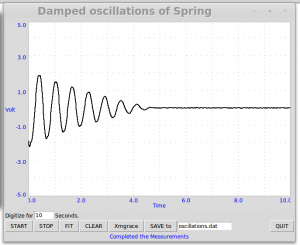Today I worked on Resonance Experiments using speaker instead of tuning fork.
The experiments of resonator and resonance tube are generally performed with tuning forks. Since tuning fork produces very low intensity sound, it is not clearly audible and the frequency is fixed. therefore the length of the resonance pipe must be changed to adjust with the frequency of tuning fork.
We used a speaker connected to SQR1 of ExpEYES. frequency of SQR1 can be varied till we get sound of resonance. a wide range of frequencies is available from ExpEYES therefore it is easy to do this experiment with various sizes of tubes and resonators. We used a mic to study the amplitude.
Here is the experimental set-up

 Wrote a python program to change frequency of SQR1 and to plot the frequency v/s amplitude graph. The program for frequency response study of pizzo buzzer was already available. Just made few modifications required for this experiment.
Wrote a python program to change frequency of SQR1 and to plot the frequency v/s amplitude graph. The program for frequency response study of pizzo buzzer was already available. Just made few modifications required for this experiment.
I did experimental trials with a measuring flask, plastic pipe, conical flask and a round bottom flask. Resonant frequency is between 300Hz to 750 Hz which varies with length of tube and volume of resonator.







